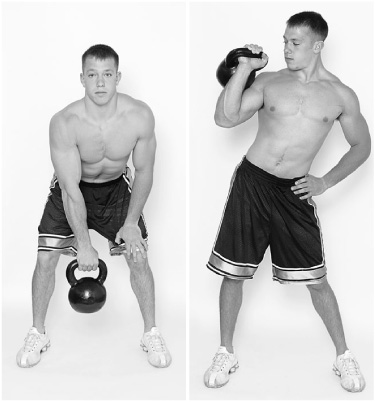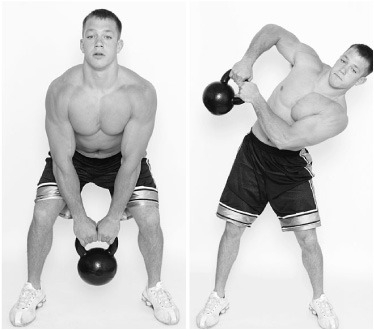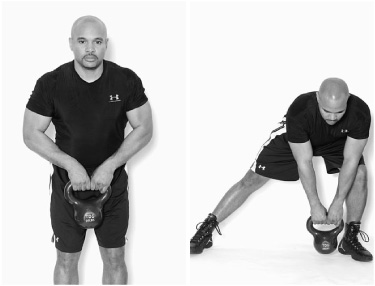
Chapter 3 continues heavy ballistic training with the single clean, double snatch, and sidewinder. It then finishes with the extremely effective movements of the side shuffle and double press.
The single clean is probably my all-time favorite kettlebell movement. When performed with heavy weight, the single clean packs a punch for most of the body. I created this variation of the clean for grappling sports, though it works great for any athlete who needs a great deal of pulling power and hip explosiveness. This might include rowers, climbers, football players, or strongmen. It is also brutal in developing grip strength, an often overlooked aspect of athletic performance. This variation requires the athlete to grip a heavy weight with one hand, pull it off of the floor, and then rotate it over the side of the shoulder while leaning to the other side. It is somewhat like slinging a large duffle bag over the shoulder, except in this case the duffle bag could weigh as much as a person.
The double snatch is one of the toughest exercises in terms of the amount of power required to execute it, as well as the overall shock to the body. It is similar to the single snatch, except that it is double the fun, requiring two kettlebells. It requires an extra step in lowering the weight. The double snatch demands that the athlete be totally committed to the execution of this exercise. There is no partially completed repetition for this exercise—only success or failure, where failure might result in injury. When performing this movement, concentrate fully on proper technique and give 100 percent from the very beginning. Otherwise you might get caught halfway through the range of motion with two kettlebells in your hands and no chance of locking them out.
In the lowering portion of the double snatch, I like to include the extra step of lowering the kettlebells to the shoulders and then taking them back down either to the floor or between the knees for the next repetition. This keeps the kettlebells from pulling you forward, which is somewhat likely with the combined weight of the kettlebells, large range of motion, and awkward body positioning. I actually picked this step up at a clinic I hosted many years ago, where I mentioned the problem of balance with the double snatch. One of the more advanced participants brought this innovative technique to my attention, and I have been using it ever since.
The sidewinder is a squat-pull variation. It reminds me of a double leg takedown in wrestling; in fact, it is quite often included in programs I develop for wrestlers. The athlete starts the same as for a squat-pull, and then leans to one side, scooping the kettlebell up into the opposite underarm. This can be repeated for one side or alternated, which is my preference. The sidewinder gives you pickup strength in the lower body but adds an upper-body pull and trunk development as well. In addition, it teaches you lateral movement in the upper body.
Like the sidewinder, the side shuffle teaches the athlete how to move laterally with weight. It can be performed on an aerobic step, a block, or the floor. In this movement, you begin in a crouched position. Ankles, knees, hips, and elbows are all bent, and the feet are almost touching. You take a large step to the side with one foot and then point the kettlebell to just inside that ankle. This creates a stretch along the groin, hamstring, and buttock of that leg. You then quickly push back to center and shuffle to repeat the movement on the other side. Back and forth you go with speed and quickness. Very little time at all should be spent in any one of the three positions. You should be constantly in movement. The side shuffle is excellent for any sport requiring lateral movement. This would include sports such as basketball, soccer, grappling sports, football, and both field and ice hockey.
Last, this chapter includes the double press. It is a tough upper-body movement because you aren’t given any breaks and you are forced to press in a large range of motion due to your upright stance. You also are using two kettlebells, so your shoulder balance and stability are tested as well. This exercise could be performed with dumbbells, but they do not give you the complete range of motion that kettlebells do. When pressing with kettlebells, you actually bring your hands to the front of your shoulders and get a deeper stretch than with dumbbells, because the weight is on the outside of your forearm and therefore not inhibiting the range in any way. Also, because of the position of the kettlebells against the arms, you have to be constantly pulling the kettlebells in to keep the weights from falling to the sides. This job goes primarily to the anterior deltoids and the pectoral muscles and adds further challenge to this exercise. You will find yourself starting with lighter weights than if you were using dumbbells.
The single clean is arguably the most difficult of the clean variations to learn. It is, however, well worth your effort because it translates beautifully to sports such as football, wrestling, judo, and jujitsu. I developed this particular style of clean for grappling sports in particular. Remember, a clean is a pull to a racked position on the outside of the upper arm and shoulder.
Start as you would for a one-hand swing. As the kettlebell swings forward, pull your elbow back into your side. Just as the kettlebell begins to flip over your elbow, lean to the side away from it. This pushes your hip out, which helps support the weight. The kettlebell should land smoothly in the racked position. As the kettlebell begins to make contact with your body, bend your knees slightly to absorb some of the shock. Pause briefly, and then tip your elbow up to direct the kettlebell down for the next repetition.

Single Clean Note that the setup for the single clean is the same for the one-hand swing as well as the single snatch. Also, view how the hip of the model presses toward the kettlebell to give extra support just as in the setup for the single press. Kettlebell training can be reduced to a handful of body alignments. The lesson here is to be efficient.
SINGLE CLEAN: KEY POINTS
1. Set up as you would for a single swing.
2. Pull your elbow to your side as the kettlebell reaches waist height.
3. Lean away from the kettlebell as it flips over your elbow.
4. Rack the kettlebell on the outside of your upper arm and shoulder. Do not allow your hand to go past your shoulder in the rack position.
5. Slightly bend your knees to absorb shock as the kettlebell comes into contact with your body.
6. Tip your elbow to direct the weight toward the floor for the next repetition.
The double snatch is performed with two kettlebells. Set up as you would for a double clean. Keeping your head up and your shoulders back, take a big backswing. Explode forcefully from the bottom, and drive with your whole body. When the kettlebells are approximately 12 inches from the top position, push into the handles as you would for a single snatch. When executed properly, there is very little impact on the forearms. At this point, lower the kettlebells to your shoulders, and then tip your elbows to direct the kettlebells downward. This step keeps you from being set off-balance by the weights. Swing the kettlebell between your knees, and explode back up for the next repetition.
Double Snatch The flat back and correct posture in the beginning of the double snatch make all the difference in the success of this movement. Note that at midpoint, the knees and hips are extended to transfer the momentum gained in the bottom position to the lockout. At the endpoint of the movement, the weights are fully extended overhead and are properly aligned with the body’s base of support.
DOUBLE SNATCH: KEY POINTS
1. Set up as you would for the double clean.
2. Use a strong backswing.
3. Snatch both kettlebells as you would for a single snatch.
4. Push into the kettlebells 12 inches before the top of the movement.
5. Lower the kettlebells to the shoulders before tipping down into the next repetition.
The sidewinder is a variation of the squat-pull discussed earlier in this book. It is a great exercise for grappling sports like wrestling because it will assist you when drilling pickups, as well as single- and double-leg takedowns. Also, you just may want to use this variation to spice up a stale routine.

Sidewinder Again, the beginning sidewinder position resembles the starting positions of the swings and cleans. It is basically a squat-pull to the side. To get any weight to move, the knees and hips need to be quickly extended. This brings you back to the basic deadlift, or linebacker position as I call it.
Begin by setting up as you would for a squat-pull. As you extend your knees and hips, lean away from the kettlebell to one side. At this point, pull with your top arm, bending your elbow farther. As you lower the weight, center your trunk once again. Explode out of the bottom position, and repeat with the other side. Continue to alternate sides until your set is complete.
SIDEWINDER: KEY POINTS
1. Set up the same way as for the squat-pull.
2. Extend your knees and hips, and begin pulling the kettlebell toward your chin.
3. Lean to one side, away from the kettlebell.
4. Continue pulling with your top elbow.
5. Center up as you lower the weight.
6. Switch sides as you drive up for the next repetition.
Very few exercises prepare you to move laterally, yet most major sports such as football, basketball, and soccer require almost constant lateral movement. To help prepare athletes for a quick change in direction, a friend and I developed what we call the side shuffle. This can be performed over a step, over a low bench, or flat on the floor. Begin by holding the kettlebell with both hands. Bring your feet together, and bend your elbows and your knees. This puts you into a sort of crouching position. Extend one leg straight out to the side, slightly farther than a normal stride. Follow that with your arms so you are pointing the kettlebell at the space just inside your ankle. Next pull your arms and leg to the center, and repeat with the opposite side. The transition from side to side should be a quick gliding motion. As your technique improves, pick up your speed.
1. Hold the handle with both hands.
2. Bring your feet close together.
3. Bend your elbows, waist, and knees.
4. Extend one leg straight out to the side.
5. Follow that leg with your arms, pointing the kettlebell to the inside of your ankle.
6. Pull your arms and leg to center, and repeat on the opposite side.
7. Transitioning from side to side should be a quick gliding motion.

Side Shuffle To perform the side shuffle, start in a sort of crouched position with elbows and knees bent. Think of a hockey player sprinting down the ice. When you push off to the side, you lunge as deeply as you can and then shuffle through the midpoint of the exercise to the other side.
Clean the kettlebells to the outside of your shoulders. Bend your knees slightly, and tighten your stomach to stabilize your lower back. Looking straight ahead, press the kettlebells overhead with your arms fully extended. Pause briefly, and then lower the kettlebells until they are once again on the sides of your shoulders. Your elbows should be tucked into your sides.

Double Press To maximize the range of motion of the double press, you should start in the top position of the double clean if possible. This gives you up to 6 additional inches of range and allows for a much fuller development of the shoulders. When pressing the kettlebells, extend your arms completely overhead. The kettlebells should be directly over the middle of your feet and not leaning to the front.
If you feel like trying slightly heavier weights, you can add a push with your legs. This would simply be called a push-press. For this technique, begin by bending your knees and pressing your feet into the floor to gain momentum. The push-press is sometimes used to prepare for the next weight advancement in the press.
DOUBLE PRESS: KEY POINTS
1. Clean the kettlebells to the sides of your shoulders.
2. Look straight head, tighten your abdominal muscles, and slightly bend your knees.
3. Press to full extension.
4. Pause briefly at the top; then slowly lower the weights until the kettlebells are in the starting position.